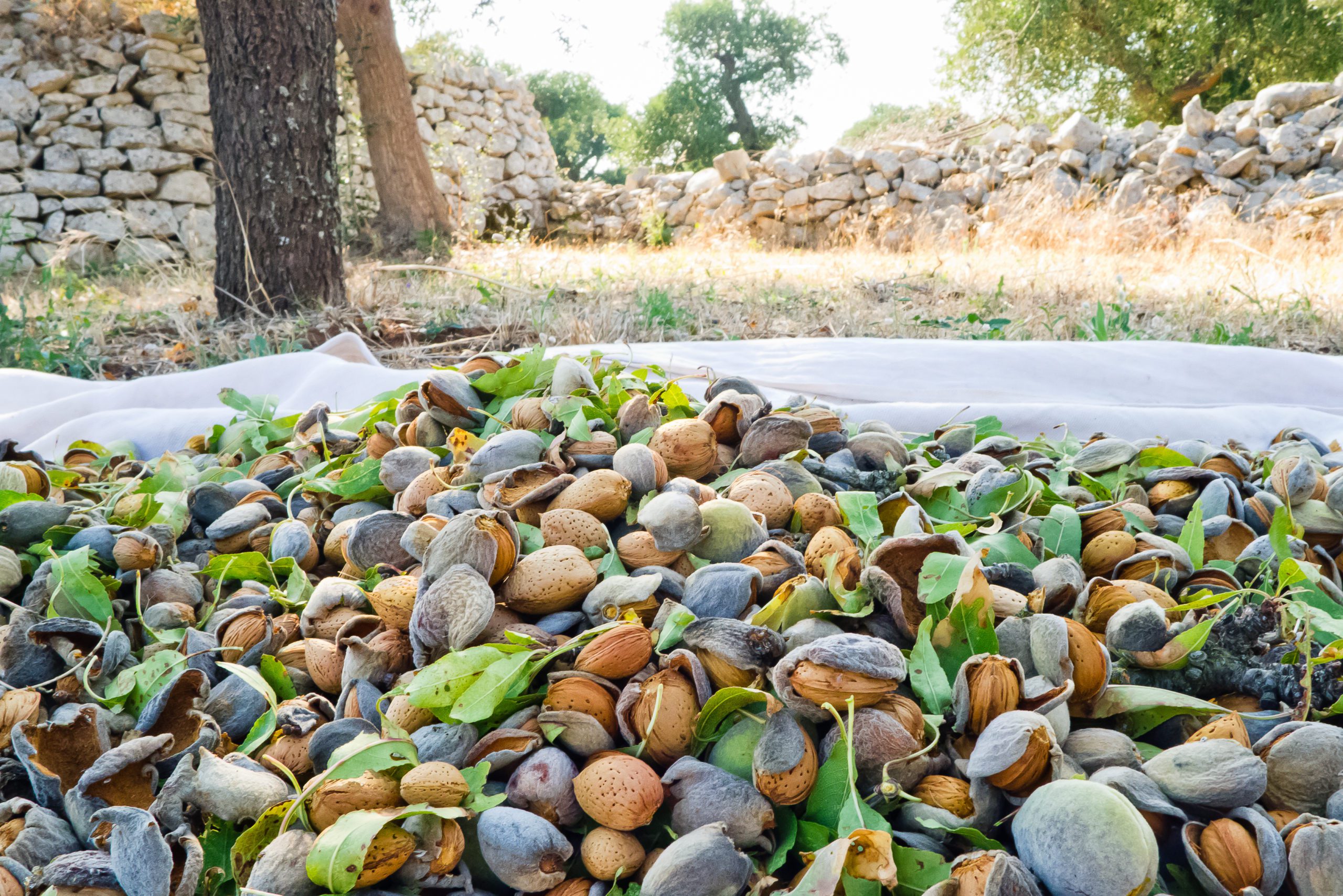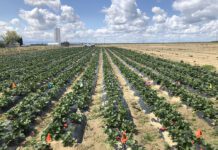The journey toward off-ground almond harvest has begun. A panel of growers, industry leaders and researchers led a discussion of this momentous move at the 2019 Almond Conference.
Reducing Dust
One of the main drivers of this journey is the reduction of dust at harvest.
“The 2025 goal of reducing dust by 50 percent can’t be reached without off-ground harvest,” Patrick Brown, University of California (UC) Davis plant sciences researcher, told the audience.
Most California harvest equipment manufacturers are participating in the journey toward off-ground harvest, collaborating with researchers and participating in field trials, session moderator Brian Wahlbrink of Sperry Farms
said.
Studying Off-Ground Harvest
Brown and other researchers, equipment manufacturers and growers have been studying the options for off-ground harvest, along with challenges and costs. The economics of drying the nuts, ensuring kernel quality, changes in harvest equipment and new configurations for orchard establishment were all weighed against elimination of blowing and sweeping operations, reduction in weed control, reduction in insect damage, and reduced labor costs.
Chris Simmons, UC Davis Department of Food Science and Technology, discussed three different scenarios of off-ground harvest: shake and catch then lay on ground to dry; shake and catch and transport to drying lot; and shake and catch and transport to facility for mechanical drying. Losses due to windfall nuts could cause a decrease in yields, Simmons noted.
The first scenario in a model 100-acre orchard showed a small increase in profit due to lower capital costs. The second scenario incurred costs for tarps on the ground or soil stabilizers where almonds are to be dried. Growers may not have land available for this practice, Simmons said. The third scenario does have the potential for an increase in profits considering drying and transport costs. However, higher moisture nuts will increase drying costs and there currently is limited drying capacity.
Next Steps in the Journey
The next steps in the journey, Simmons said, will be to determine the true cost of an off-ground harvester including depreciation and capital recovery, fuel and labor efficiency, maintenance, cost to produce, competition and penetration pricing. Other costs to consider will be mechanical drying, and how much dust is mitigated under each harvest scenario.
Despite the challenges, Simmons said there are promising signals that off-ground harvest could be cost-effective for growers.
Adapting Orchard Systems
Ted Dejong, UC Davis, said adapting almond orchard systems to accommodate off-ground harvest will require a change in mind set prior to planting a new orchard.
Rather than primarily thinking about choosing a density to maximize yield and accommodate an irrigation system and operation of orchard equipment, DeJong said, the type of harvest equipment that will be used becomes a primary consideration.
Those types include an over the row type harvester used in high density olives, the Tenias type of over the row that can accommodate medium size trees, a side by side shake-catch machine similar to what is used in pistachio harvest and a wrap around shake-catch machine similar to a 1970s model.
DeJong said each of the off-ground harvest systems have their advantages and disadvantages, but they all require trees and orchard canopies to be smaller than what is now in production. Trees will also need to have higher crotches. One of the most urgent needs accompanying off-ground harvest is size controlling rootstocks. This is a major change as in the past rootstocks have often been selected for their ability to enhance tree vigor and mature tree canopy size. These rootstocks will present a challenge with anchorage as many of the dwarfing rootstocks have relatively poor anchorage.
Brown reported the results from 2019 trials to determine losses from windfall nuts in an off-ground harvest scenario. Trials were done in Kern and Butte counties. Preliminary analysis shows windfall from zero to one percent with the majority of the sites reporting less than 15 pounds per acre. Brown reported that fruit falling before four weeks of normal harvest are very poor quality. Quality and size of kernels is not compromised at the two-four week early shake. Moisture is 10-15 percent higher at greater than two weeks early shake. Brown said the potential for navel orangeworm (NOW) damage and hull rot is greatly increased with fruit maturity.
He plans to continue analysis of regional and cultivar data and repeat studies will be conducted in 2020 with added high aflatoxin sites and high NOW and hull rot sites.
Drying
Drying fresh almonds is another challenge in this journey. Dr.Michael Coates, Plant and Food Research in Australia, said batch drying or stockpile drying are being studied.
Coates said fruit that takes 3-10 days to dry in a tree row, can take two-three weeks to dry in a stockpile or batch dryer with evaporative cooling caused by insufficient air flow.
Providing enough airflow to remove the water coming from the fruit and keeping the air warm enough that moisture keeps moving through the fruit is important to the process.
Batch drying, Coates noted, is not new for other tree nuts, but parameters need to be established for the machines so they can be tuned to dry almonds. Batch drying is being done at UC Davis to determine drying times for different varieties.
Coates said stockpile drying is currently the direction being taken by research. This will necessitate growers to have space for stockpiles or the processors may take this role.
Determined so far is that the stockpile must be oriented perpendicular to the wind, thermal mass can keep fruit from over drying and that mechanical air needs to be high volume and low velocity.
Quality concerns with mechanical drying of almonds was addressed by Zhongli Pan Ph.D.
Food Processing Research Group Department of Biological and Agricultural Engineering UC Davis.
Drying temperatures, moisture effects on quality, performance of different varieties and costs were part of his research.
Comparing Harvesters
Comparing almonds harvested conventionally and off-ground, Pan said the off-ground harvest yielded cleaner samples, and nuts had less insect damage.
Research showed a slight change in oil quality for high temperature commercial drying. The hot air drying process produced no cavity in the kernels, caused no significant kernel color change and no significant concealed damage. Initial moisture and drying conditions did not show significant effect. Recommended conditions are up to 60 degrees Celsius and 2m/s. Energy cost was 0.23 to five cents per pound. Sorting can reduce energy cost.

Cecilia Parsons
Cecilia Parsons has lived in the Central Valley community of Ducor since 1976, covering agriculture for numerous agricultural publications over the years. She has found and nurtured many wonderful and helpful contacts in the ag community, including the UCCE advisors, allowing for news coverage that focuses on the basics of food production.
She is always on the search for new ag topics that can help growers and processors in the San Joaquin Valley improve their bottom line.
In her free time, Cecilia rides her horse, Holly in ranch versatility shows and raises registered Shetland sheep which she exhibits at county and state fairs during the summer.
















